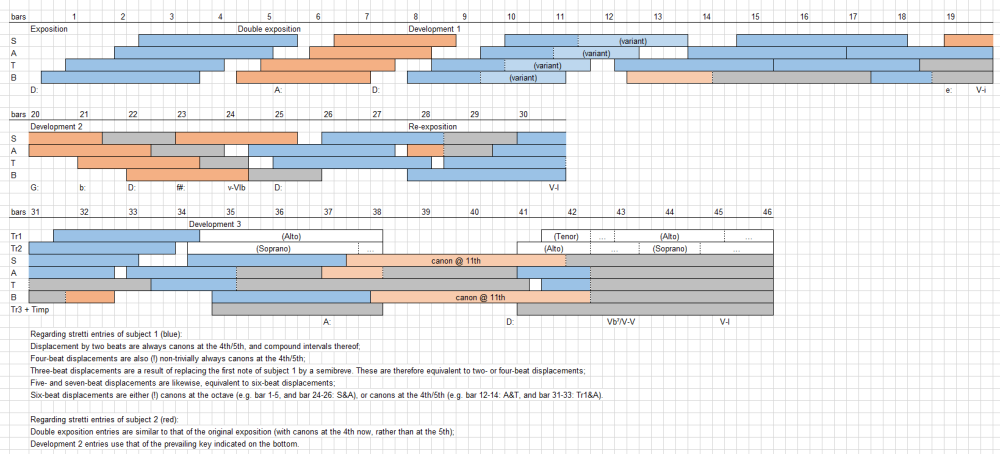Leaderboard
Popular Content
Showing content with the highest reputation on 02/25/2023 in all areas
-
Using Dice to determine metrical feet/rhythms and accents A somewhat recent discovery of mine is using metrical feet from poetic meter to determine the rhythms of a given phrase of music. For music in compound or complex meters, a 4-sided die can be rolled once for each beat of music: Duple Feet 1 2 3 4 Iamb (s L) Trochee (L s) Pyrrhic (s s) Spondee (L L) An 8-sided die can also be rolled once for each group of two beats to determine the rhythm of a phrase in any simple meter: Triple Feet 1 2 3 4 5 6 7 8 Anapest (s s L) Dactyl (L s s) Amphibrach (s L s) Amphimacer or Cretic (L s L) Bacchius (s L L) Antibacchius (L L s) Tribrach (s s s) Molossos (L L L) Some of the metrical feet are more open to interpretation than others and some don't fit within their intended meter and must be made to fit by taking up more or less than their allotted beats in the phrase. Also note that the duple feet are actually more useful in compound meters, while the triple feet are more useful in simple meters because of how long the stressed (L = Long or stressed) and unstressed (s = short or unstressed) syllables within each foot are meant to take. By rolling a 6-sided, 8-sided, or 10-sided die one could also arbitrarily determine how many feet will be used in a given phrase of music. One could use this to introduce rhythmic space into the phrase, or come up with phrases that may end up having very irregular lengths. Instead of rolling dice one could also use melodic mining techniques to extract rhythms from spoken speech using an understanding of these metrical feet. This is probably already how many people go about setting words to music. But one's composition need not be vocal or choral or even include the original words on which the rhythms of the music are based to use this technique. These feet can also be very useful in referring to the rhythmic character of certain phrases. Actually my whole exploration into these metrical feet was sparked by @Henry Ng Tsz Kiu's review of @ComposaBoi's Symphony No.2 Part 1 when he referred to one of the themes in the symphony as being anapestic!2 points
-
Using Dice to pick a Mode or Scale in which to compose in Perhaps a method of using dice which still allows the composer quite a bit of freedom is using them to pick a mode in which a given melody will be set. For this purpose I have made the following table, the choices in which are determined by rolling a 4-sided die with an 8-sided one: Modes 1 2 3 4 5 6 7 8 1 Lydian Ionian Mixolydian Dorian Aeolian Phrygian Locrian Octatonic Diminished Half-Whole 2 Lydian Dominant (Acoustic Scale) Locrian #2 Mixolydian b6 Phrygian #6 Melodic Minor Lydian Augmented SuperLocrian Altered Octatonic Diminished Whole-Half 3 Dorian #4 Lydian #2 Phrygian Dominant Locrian #6 Harmonic Minor Ionian Augmented Locrian b4 bb7 Bebop Dorian (b7 & nat. 7) 4 Hungarian Minor (Harmonic Minor #4) Neapolitan Major (Phrygian #6 #7) Harmonic Major (Ionian b6) Blues Major Minor (Aeolian #3) Aeolian #4 Gypsy/ Byzantine (Phrygian #3 #7) Bebop Dorian (b3 & nat. 3) This method has limited flexibility however, unless one rolls the dice again when a contrasting section of music is needed. This can also be used with a 12-sided Musician's die to determine the actual tone around which a given mode should be centered. One can of course, customize one's own table with various different other choices in the 4th row. There wasn't enough room to include all the different kinds of bebop scales, and all the other scales are heptatonic. With more choices, one could probably put together an even more comprehensive list.2 points
-
Without any hesitation, the Gratias Agimus Tibi from the Mass in B Minor. Here is a fugal diagram for interest: As can be seen here, the piece reaches an extraordinary level of motivic saturation (think BWV 874) - but what sets this fugue particularly apart, is the journey it takes the listener on, and the emotions it evokes upon the listener. On the surface, it is one of the best conceived and executed example of a continual crescendo. But dig deeper and you find yourself looking at a complex feat of musical engineering founded on a basis of theory and logic - not feelings alone. This to me is the absolute embodiment of the beauty of Bach, and what makes Bach special. And on the opposite side of the spectrum - the opening choral fugue from BWV 105 (as a Prelude - Fugue pair!): I say "opposite" here because of the piece's fundamental simplicity in its construction. It is only knowing the context - that Bach had composed this entire cantata in the span of roughly three days, that it becomes clear why this is impressive. Under the time constraint, Bach generated some key musical ideas (for this fugue: a 5-bar long quadruple counterpoint) and germinated them in very simple, but highly effective ways. Then there's...this thing from BWV 108. It's just flat-out weird. The first section for example, is stuck in an endless loop of permanent V-I progressions (at quaver speeds!). I love it though, for the unique sound it has!2 points
-
So, since I've used dice before to help me compose, I thought I'd start a topic where I could post all my thoughts/techniques about how precisely one can compose using dice. If you've composed using dice and found a technique that's worked for you feel free to add to the discussion! At the minimum you will probably need two regular 6-sided dice. But for my purposes I've purchased a set of fantasy RPG dice which includes 4-sided, 6-sided, 8-sided, 10-sided and Musician's Dice which are 12-sided and labeled with the 12 tones of the chromatic scale. Also, there's some regular 12-sided dice labeled with numbers, and 20-sided dice as well.1 point
-
(I pretty much copied the description of my video for this commentary.) The story with this piece is quite interesting. On the 22th of December of last year I woke up a bit late, and as it is common in me I was tired and I tried to keep sleeping. But for some reason some negative thoughts about a friendship hit me and made me feel bad and guilty (don't ask personal questions please, thanks), and out of nowhere the Rachmaninoff-like passage of this piece came to my mind. It felt as if my mind was trying to say "sorry" through music because I struggle with words sometimes. The thing is that I decided to go to my piano to write down the fragment because I considered it was too good to let it slip from my hands (at the time I had no idea it was similar to the 3rd movement of Rachmaninoff's 3rd symphony)(there is also a bit similar to Chopin's Op.10 No.3). So this piece pretty much originated from a dream, because I wasn't really awake (I ususally know when I'm dreaming). I even cried when I found the Ebm7 chord with that dissonant leap that goes to the 9th, and I don't think I have ever composed anything else so straight from my heart. The last section also hit me pretty hard when I got it (yeah, I cried again...), but I actually almost improvised it, I never experienced such fluency in a composition. The piece still took me 10 hours to make. Due to some thematic connections, style and a suggestion by my friend Ferran I decided to combine this piece with Nostalgia and create a small set. It will be called "Two dream fantasies". Another detail I could mention is that the repeated chords at the beginning are inspired by my friend Theodore Servin. I hope you enjoy the piece and that you can feel all the emotion I poured into it. 🙂1 point
-
Yo So this is clearly phenomenal, and like @Henry Ng Tsz Kiu, I'm in awe of the orchestration. It's your biggest strength in the piece to me, as you wield such a masterful grasp of its power, ferocity, lushness, beauty, vividness, intensity, etc. etc. This is one of the best displays of orchestration I've ever heard on this site, and I've been roaming around here for over a decade. I could go on and on about it tbh. I loved it that much. Especially the more subtle sections. The fiery bit around 152, leading to a grander version around 210 (these measure numbers are probably way off, I'm just skimming the score now), the little spot at 262 leading into the fantastic largo section, the Mahler-esque next section...it goes on lol. I really like your goal of keeping to 2 motifs for the bulk of the development. I think, for one, it makes your music very cohesive, but it's also a great display of your compositional technique. Whenever we limit ourselves and impose restrictions, I feel like we get more creative when boundaries are given. And speaking of that: You have more movements in the works, right? Why not establish themes in this one and develop them later? Even though I heard various shades of Stravinsky throughout the piece, it sounds like he was an inspiration to you rather than a quote. This was very neo-Stravinsky to me in multiple ways, but you gave it enough character of your own to make it unique to you. I have two critiques, and I'd say they're subjective, but take them as you will. The first one is very minor, but lately I've been more picky about this because I've struggled with this in my own music. The ending doesn't do it for me. You could literally chop off the last 3 measures and it would be way better imo, just to keep that dissonant language going a bit more. The final cadence just doesn't sound like it belongs, like you gave us a riveting story and on the last page you said, "oh, and they lived happily ever after." But hey, it's your music, and if you like it then great! My bigger issue was the pacing throughout the... let's see here... 27 minutes! With all of it's wonderful color, textures, harmonic choices, motivic development, and every other aspect of music, it was mainly slow throughout. Sure, there were faster moments here and there, but most of them felt like builds and swells versus presenting the music at a faster pace. I felt like you constantly lost momentum, and it would have been great to me at least to have a bit more drive, especially when you built up your music. Who knows though, maybe you have that in mind for future movements (which is why I don't like listening to one movement without hearing the others, but this was too good not to share some thoughts). But even if you do, it's 27 minutes long, it could be a symphony in one movement to me. Just my own personal opinions though. This is wonderful in every way, and I'm really glad you shared a major work with us. I'll never understand how you can work backwards from how I work; I just can't keep track of everything in the DAW, I have to see the notes when writing. But your method is obviously finely tuned, and your artistry is something that I admire every time I hear your music. Masterful job, and thanks so much for sharing this! I'll be revisiting this in the future to study up on any questions I have orchestrating, as well as to enjoy this once more. 🙂 - #1 better-than-Henry gmm fanboi1 point
-
Hi Henry, thank you very much for your very thorough review, and your kind words. I’m glad you enjoyed it! I’m glad you appreciate the motivic development. You are right to observe there are additional motives, especially in the B section, that we’re not developed as extensively. Part of me feels like this is a missed opportunity, but at the same time I didn’t want to get too carried away. I thought it would be better to focus on two motives to avoid being too overwhelming and complex. I will say the cello motive you point out is supposed to be Motive 2 (alternating descending/ascending by scalar motion). I’ll also note the octatonic modulation is intentionally used in both the first and second statements of the A theme to give them unity, while still altering the mode for variety. I’m glad you noticed these quotations. I try to draw inspiration from my favorite composers (e.g. Mahler, Stravinsky, Strauss, as you mention) while still adding enough variation to make it my own. It’s fair to note that the return of the A then in the second half is very similar to the first time. I address this in my response to your questions on the form. While I think it is best to describe the form as a rondo, I intended for it to be somewhat of a hybrid of rondo and sonata. When viewed as a sonata, the A-B-A form the “exposition” the C-D form the “development”, and the second iteration of the A-B-A form the “recapitulation”. At the same time, I wanted this movement to function as somewhat of a “symphony within a symphony”. That is where the rondo form comes in - the sections of the rondo act as “movements” of a “symphony”. From this perspective, the “A-B-A” form the “first movement,” the C section forms a “scherzo” (albeit not in triple meter), the D section forms the slow movement, and the second “A-B-A” forms the finale, which draws and expands ideas from the “first movement”. In this way, the movement acts as both a standalone “symphony” due to the rondo form, while still imitating the sonata form typical of the first movement of a symphony. There is no program, it is absolute music. I am curious if you visualize some program for yourself? Thanks again for your review! This forum is lucky to have someone like you who can put as much time and attention into analyzing its members' music. I'm currently working on reviewing the rest of your Clarinet Quintet in return. -gmm1 point
-
Sorry for the late reply. Thank you! I'm glad you liked it. Luckily I didn't have to do much with this piece because the music unfolded by itself. I love sharing my inner world through music. Thank you. That moment is very dramatic, the augmented 6th is a really effective chord. No, I didn't know about him, thank you for letting us know about that composer. I hope to be posting new pieces here when summer comes. 🙂1 point
-
1. BWV 903 Chromatic Fantasy and Fugue 2. BWV 831 French Overture 3. Prelude and Fugue in A minor 4. "Little Fugue" in G minor 5. "Great Fugue" in G minor If anyone is interested in my favorite Bach fugues here are my favorites, and the performances that I adore. Comment your favorites!1 point
-
She's one of the best, when I hear her play Bach, it's so peaceful. Like a child playing a game, there's only innocence and ease. And great pick sir, this is one epic fugue. Thank the heavens for gerubach (and smallin). The mass is beautiful, although I never really quite listened to it closely yet. Thank you for specifying the fugue, now you have sparked me interest in it. I gotta say that most of fugues are a journey, slowly building up to the climax when all the voices re-enter >.<. But I see your point.1 point
-
Yes, an interesting topic (to which I've responded before), having several dice with weird numbers-of-sides. Have used the numbers to create melodies with 1 = the keynote but not for aleatoric composition beyond that. If a number comes up more than once, so does that note. I don't need dice to distort rhythm! I use a 14-side dice and work on until 13 or 14 comes up which mean "end of" so melodies can be very short (and which will likely get discarded) I cheat by doing several and choosing those I think might be usable. It'll be particularly interesting how other members are using dice for composition. It needn't be to come up with contemporary-sounding music though in my case it seems to. .1 point
-
The overall structure appears quite strange to me. The opening ritornello is immediately restated with a vocal line - this is used (somewhat uncommonly) near the end of certain choruses/arias, but from memory I cannot recall a single movement from Bach's oeuvre that employs this. At least in the vocal opening, the ritornello is always varied in some form (using the usual techniques from the instrumental inventions). The variation can be very small (e.g. just inserting a few bars of sequences between two sections, or transposing the end section of the ritornello to the dominant), but it nonetheless creates a sense of development. A consequence of this is that there is a strong cadence in the tonic key, which is again, extremely unusual. I'd also say the flute line desperately need some breaks too. Even something as simple as dropping out the flute line near strong cadences would suffice. The material you've written however, actually looks very solid. I think all it needs is some tweaking in the order of presentation of things, and writing a few extra small blocks to fully connect things.1 point
-
Quite interesting. It was amazing the discovering of indeterminacy. Although we know this techniques were used before, I think it was John Cage who developed the method. I wrote some pieces using cards and different levels of control/indeterminacy of the parameters of the music. I liked them. Also, sometimes I catch one of my cats. walking on the midi keyboard and put it to record. I consider it as an aleatory music. Afterwards, I add some harmony.... Dice method is intriguing, perhaps I'll try.1 point
-
Ha thanks for mentioning my post and I am happy to help inspire you Peter! This will be a good method for aleatory music as well. Or the 12 sided Musician dice can be use d for a serial melody with the repeated note not counted! Or the regular 6 side dice can determine the period of the piece: Medieval, Renaissance, Baroque, Classical, Romantic and 20th century. Or the number of the dice can determine what interval you have to follow after the initial notes.1 point
-
Really lovely piece of music, it has a good energetic feel to it. I particularly liked the piano part right around 3:40. The only thing that threw me off were the pauses. A couple of them felt like the music just randomly stopped and then started going again. Other than that I really liked it!1 point
-
My favourite fugue must be these two: The fugue in the C# minor prelude and fugue WTC I since I freakingly love C# minor, and there are 5 voices and three subjects there! There are many recordings I love on this one, but I freakingly love the one by Nikolayeva: https://youtu.be/ICb-JdD_AQw&t=2m54s I also love the contrapunctus XIV in Die Kunst der Fuge, sadly Bach didn't complete the supposed quardruple fugue! But I like the completion by the Netherlands Bach Society:1 point
-
1 point
-
Hi @BipolarComposer , I like the harmonic language in it! But I have the same feeling as Alex that the trip is quite a scary one! There are some simplistic moments but mostly is quite frightening! Does the trip give you a bad feeling? Is that Prokofiev's Toccata op.11? It's freakingly dynamic and difficult to play! Thanks for sharing! Henry1 point
-
1 point
-
Hi Oliver. Think you hit the brief really well! I probably would've used a rainstick for the rustling leaves. That was the first instrument I thought of. And piccolo for the birdsong. Is the winning piece to be used in a movie or TV show?1 point
-
Hey Ivan Sorry, for some reason just saw this 😕 I was going to check out the OST, but I went down a rabbit hole of watching a bit of gameplay. This game looks awesome! I really like the dark yet beautiful atmosphere. I haven't played it myself, but I want to try it out. I really like the whole ecosystem type of game, where you're just exploring and trying to survive. From the videos I watched, I'm really impressed with the sense of AI that's involved in everything that's trying to eat you and stop your progress. I'm a big fan of dystopian novels/movies, so this seems right up my alley. Thanks for making it known to me! In terms of the tracks I liked, Bio-engineering, the various "threat" tracks, and Deep Energy stood out, but in general I like the overall vibe of the soundtrack. I love ambient textures over cool rhythms, even when they don't seem to mix at first. In fact, at some point I'm going to write an instrumental metal album that uses this style as a core property of it. This is probably not your style, but I've been really inspired by this band that uses this method as a foundation to their music, particularly this track, and especially the section at 1:40: BTW, this is one of the coolest album covers I've ever seen!1 point

.thumb.png.8b5b433a341551e913a34392660bc95b.png)





